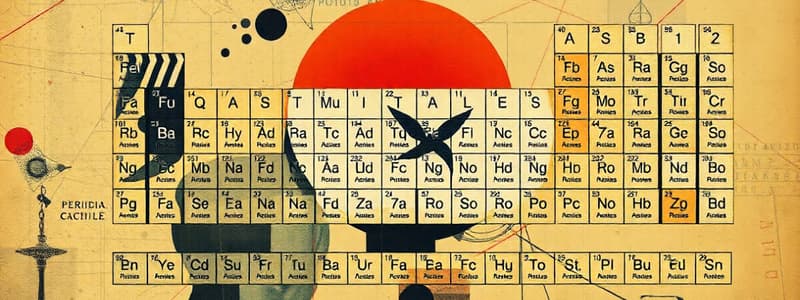Podcast
Questions and Answers
What is the periodic trend for atomic radius as you go from left to right across the periodic table?
What is the periodic trend for atomic radius as you go from left to right across the periodic table?
The atomic radius decreases.
What happens to atomic radius as you go down a group in the periodic table?
What happens to atomic radius as you go down a group in the periodic table?
The atomic radius increases.
What is ionization energy?
What is ionization energy?
The energy required to remove the loosely held outer electron from an atom.
How does ionization energy change as you go from left to right across the periodic table?
How does ionization energy change as you go from left to right across the periodic table?
What is electronegativity?
What is electronegativity?
What is the trend for electronegativity as you go across from left to right in the periodic table?
What is the trend for electronegativity as you go across from left to right in the periodic table?
How does electronegativity change as you go down a group in the periodic table?
How does electronegativity change as you go down a group in the periodic table?
The ionic radius of a cation is smaller than its atomic radius because there are fewer ______.
The ionic radius of a cation is smaller than its atomic radius because there are fewer ______.
The ionic radius of an anion is bigger than its atomic radius because added electrons ______ each other.
The ionic radius of an anion is bigger than its atomic radius because added electrons ______ each other.
The atomic structure diagrams show a sodium atom gaining an electron.
The atomic structure diagrams show a sodium atom gaining an electron.
Flashcards
Atomic Radius
Atomic Radius
One half the distance between the nuclei of two atoms of the same element.
Ionization Energy
Ionization Energy
Energy needed to remove an electron from an atom.
Atomic Radius - Period Trend
Atomic Radius - Period Trend
Atomic radius decreases as you move across a period (left to right) on the periodic table.
Atomic Radius - Group Trend
Atomic Radius - Group Trend
Signup and view all the flashcards
Ionization Energy - Period Trend
Ionization Energy - Period Trend
Signup and view all the flashcards
Ionization Energy - Group Trend
Ionization Energy - Group Trend
Signup and view all the flashcards
Cation
Cation
Signup and view all the flashcards
Anion
Anion
Signup and view all the flashcards
Electronegativity
Electronegativity
Signup and view all the flashcards
Valence Electrons
Valence Electrons
Signup and view all the flashcards
Study Notes
Periodic Table Trends
- Periodic trends describe patterns in the properties of elements across the periodic table.
- Atomic radius: Half the distance between the nuclei of two atoms of the same element.
- Trend: Decreases as you go from left to right across the periodic table.
- Reason: As electrons are added across a period, the electrons are pulled closer to the positive nucleus.
- Trend: Increases as you go down a group.
- Reason: As electrons occupy energy levels that are farther from the nucleus, there is less pull between the outer shell electrons and the positive nucleus.
- Trend: Decreases as you go from left to right across the periodic table.
- Ionization energy: The energy required to remove an electron from an atom.
- Trend: Increases as you go from left to right across the periodic table.
- Reason: As the electrons increase, the attraction for the outer level of electrons also increases, requiring more energy to remove an electron.
- Trend: Decreases as you go down a group.
- Reason: As you go down a group, the positive nuclear charge increases, but the outer electrons are farther from the nucleus resulting in a decrease in ionization energy.
- Trend: Increases as you go from left to right across the periodic table.
Studying That Suits You
Use AI to generate personalized quizzes and flashcards to suit your learning preferences.




